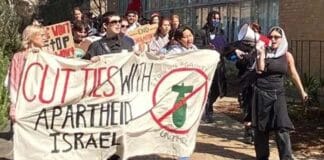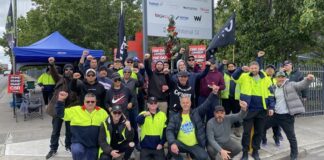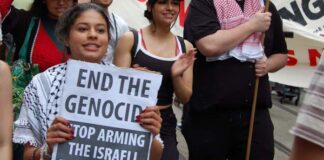The Black Panther Party inspired millions of black Americans to stand up to racism, argues Matt Meagher, but their strategy for revolution wasn’t up to the task
By the mid-1960s the US was ready to explode. The Vietnam War had produced a mass protest movement, university students were becoming radicalised against the system and major riots had taken place across the country. This was the context out of which the Black Panther Party for Self Defense emerged.
While the respectable leadership of Martin Luther King and the Southern Christian Leadership Conference had defeated segregation laws in the south and won civil rights and voting rights legislation, by 1965 the focus for Black liberation would move to the northern cities.
Black people had lived in de-segregated cities and held equal citizenship rights here for decades. But for the 15 million blacks living in the north, this had done little to end racism, poor housing, unemployment, poverty, police violence, and under-funded schools.
People had grown tired of the strategy of “non-violence” and compromises with Democratic Party officials espoused by Martin Luther King. They wanted a more radical confrontation with racist power structures.
After the shooting of civil rights activist James Meredith, Student Non-Violent Co-ordinating Committee leader, Stokely Carmichael declared, “I’m not going to beg the white man for anything I deserve—I’m going to take it. We want Black Power!”
Between 1964 and 1968, the discrimination and oppression experienced by blacks in the north expressed itself in massive riots in every major US city.
The Watts Rebellion of 1965 saw Los Angeles burn for six days with 15,000 police and National Guards deployed to quell the rebellion. 34 people were killed, hundreds injured and 4000 arrested.
In 1967, America’s fifth city and the centre of the world’s biggest motor industry, Detroit, was turned into a war zone.
Detroit’s black population targeted the police and businesses exploiting the community. Thousands of stores and buildings were looted or burned to the ground. Another 15,000 troops were deployed, this time with tanks, machine guns, and helicopters. This time 43 people died and almost 2000 were injured.
But the Black struggle found its most radical and well known political expression in the Black Panther Party. The Panthers were able to direct the anger felt by many in the black community.
They argued that capitalism was the central problem and described themselves as revolutionary socialists.
Huey P. Newton and Bobby Seale formed the party in 1966 while they were at college in Oakland, California.
The Panthers gained notoriety by “patrolling”—organising groups of armed Panthers to drive around following police cars. Carrying weapons in public was totally legal. When the police stopped a black person, Panthers got out of their car, loaded their shot guns and rifles, and shouted out legal advice.
As Newton explained, the role of the police was, “not to promote our welfare or for our safety or security. They are there to contain us, brutalise us, and to murder us”.
In May 1967, the Californian legislature, led by then governor Ronald Reagan, took steps to outlaw the Panthers’ practice of patrolling the police.
Their response was to march an armed delegation into the state capitol, walk into the public visitors’ gallery, and read out a statement denouncing the:
“legislation aimed at keeping the black people disarmed and powerless at the very same time racist police agencies, throughout the country, are intensifying the terror, brutality, murder and repression of black people.
“Black people have begged, prayed, petitioned, demonstrated, and everything else to get the racist power structure of America to right the wrongs which have historically been perpetuated against black people. The time has come for black people to arm themselves against this terror before it is too late.”
While this act saw Bobby Seale and five others charged with misdemeanors it also catapulted the Panthers into the national media.
The media frenzy helped the Panthers grow enormously. From mid 1967 to 1968, a handful of students and activists in Oakland became a national organisation with branches in dozens of cities with thousands of members and by the middle of 1968 its newspaper, The Black Panther, claimed to sell between 100,000 and 300,000 copies every week.
The Panthers released a ten-point program demanding self-determination, rights to jobs, education and housing, an end to exploitation and incarceration of black people, and most importantly, an end to police brutality and racism.
The Panthers also developed community service programs in the Free Breakfast for Children program, free health clinics, and Liberation Schools.
In just 12 months they had become a political force, especially amongst young, black people.
One survey showed that “25 per cent of the black population had great respect for the BPP”, including “43 per cent of blacks under the age of 21”. At their height they had 10,000 members.
But by the early 1970s the Panthers had almost ceased to exist. They had closed down dozens of branches across the country, centralised the party’s operations in Oakland and re-directed political activity towards an electoral strategy, running for Mayor of Oakland and in local council elections.
Under attack
The US government saw the Panthers as a serious threat and set out to destroy the group. FBI boss J. Edgar Hoover instructed his agents “to submit imaginative and hard-hitting counterintelligence measures aimed at crippling the BPP.”
The FBI’s Counterintelligence Program (COINTELPRO) was used to spy on, smear, threaten, bring false charges against and even murder Panthers.
Fred Hampton and Mark Clark were shot dead by police as they slept, in an early morning raid in Chicago. The seven survivors were later charged with attempted murder, armed violence and weapons charges, all of which were later dropped. An investigation found that the police had fired between 90 and 99 rounds to one by a Panther.
In Los Angeles, Panther leader Bunchy Carter was shot dead by a rival black nationalist group, “Organisation US”. It was later found that FBI agents had sent death threats and humiliating cartoons to each group, with the explicit intention of inciting deadly violence and division.
Much of the Panther leadership including Seale and Newton were incarcerated for long periods of time (despite large campaigns to free them).
In April 1968, Eldridge Cleaver was shot in a police attack and charged with attempted murder, subsequently skipping bail and fleeing to Algeria.
Political weaknesses
The Panthers inspired thousands of young activists in cities all over the US. But there were major problems in their political strategy.
They sought to build, in the “spirit of Malcolm X”, the “self-organization and self-confidence of black people to fight back against their oppressors”. They understood the need for black and white unity and that ultimately, as Bobby Seale put it, their “fight [was] a class struggle, not a race struggle.”
However, their main political influence was Maoism. This gained traction amongst the Panthers and other radicals in the US because it offered an anti-capitalist framework that could be separated from the discredited Soviet Union.
Mao’s claim that “power flows from the barrel of a gun” seemed to be confirmed in the Third World liberation struggles of the time, as in Vietnam. This fitted with the Panthers’ own attraction to armed struggle.
Mao saw the revolutionary party as being the primary agent for social change, as opposed to Marx’s principle, that the “emancipation of the working class must be the act of the working class”.
This meant an elitist strategy that encouraged a small number of party members to act on behalf of the wider working class.
The Panthers were right to support black people’s right to self-defence against police brutality. But the Panthers’ focus on carrying weapons led them into destructive and deadly shoot-outs with the police. This, coupled with growing state repression, meant they were increasingly consumed with trying to keep their members out of jail and running legal defence campaigns.
This posed the desperate need for mass support to defend the party. But the Panthers had no clear strategy for reaching the mass of the population.
The Panthers’ focus was mostly on mobilising the poor and unemployed, the “brothers on the block”. Eldridge Cleaver believed that it was in the ghettos where the Panthers would find the section of society most open to and able to engage in revolutionary ideas and activity.
Instead of looking to the industrial power of workers, Cleaver saw them as “parasites” that had been “[bought] off with jobs and security”.
But the anger and the will to fight back against the system was not restricted to the ghettoes. It also had a focus in the factories where black people worked.
While black people were disproportionately unemployed, there were still huge numbers working, especially in the car industry.
The Panthers’ focus on community programs was designed to build support in the black community. This came at a heavy political cost.
The massive organisational and logistical task of providing free food, school and medical services pulled Panthers away from political activity and led them to work within the system instead of confronting it.
Panther members worked with existing state services where they could to help deliver their community programs instead of focusing on their wider political and revolutionary goals.
The Panthers were not able to see that real power did not lie in fighting the police or providing services but at the point of production, in the car plants of Detroit and other cities.
The experience of the Panthers holds rich lessons for the Black Lives Matter movement and the fight against racism today. The Panthers attempted to reach out to white left-wing organisations and understood the way racism is used by the ruling class to divide and rule.
They identified the need to get rid of the capitalist system. But this requires a revolutionary organisation that looks to use the power workers have at the point of production to bring the system to a halt.






